#the bitch in question is however NOT HDS which is extra funny to me
Explore tagged Tumblr posts
Text
it do be 6am and I do be mad af for some IRL stuff so let’s write :)
#sneaky niki#lamb loose liveblogging#tendinitis or not I don’t want to think about how mad I am about IRL stuff so I will make it HDS’s problem period#oh baby I’m so mad and he’s gonna hatenme for what I’m about to do to him#also maybe I should also start reviewing ch 5 so I can post it sometime soon#idk if I’m in the right headspace for that but I’m sleep deprived and caffeine makes me sleepy so I have no solution#anyway SDY is a jealous bitch and he sniffs a useless bitch in heat from miles away#the bitch in question is however NOT HDS which is extra funny to me#ch 13 is both hilarious and sad#you’re gonna love it#this silky anteater of a an author wishes you all a good day tho!
1 note
·
View note
Text
Resident Evil 2 (2019) - Not quite the ‘re-imagining’ it purports to be (SPOILERS)
[Written: Feb 4-25, 2019. As always, act brand new on my post, you will catch the fastest block in the west.]
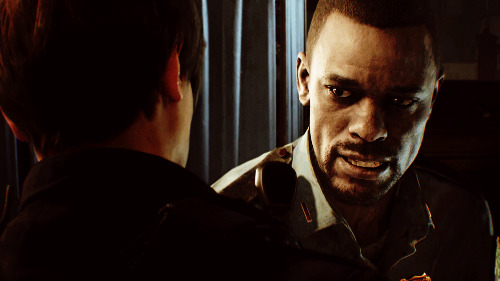
The 2019 iteration of Resident Evil 2 shares a lot of common ground with games like Silent Hill: Shattered Memories versus something like Bluepoint Games’ Shadow of the Colossus or even Sega’s Yakuza Kiwami series.
The first game is a re-imagining – effectively a reboot –, recreated from the ground up with almost little to do with its predecessor. The others are genuine remakes that change very little in the way of the framework or structure of the game and merely recreate or repair its presentation with the graphical fidelity (or control schemes) of the present era.
While both profit and rely on nostalgia, a remake has the specific ‘obligation’ to maintain what came before it. A re-imagining has cart blanche to do what it wants under the pretense that it has no obligation to restore or replicate. In the case of Resident Evil 2, it’s a bit funny in the fact that the existence of its reboot was reliant on the 2002 remake of Resident Evil.
During the re-release of the 2002 Resident Evil remake in 2015, Capcom more or less ransomed the idea of making a “remake” of Resident Evil 2 by placing the burden of that reality on the shoulders of Resident Evil HD. Or rather, the shoulders of their consumer base.
If Resident Evil HD didn’t meet publisher sales expectations, no “remake”. It was an easy sell, of course, because the Gamecube remake was not a game everyone played (on account of Nintendo console exclusivity). To no surprise, Resident Evil HD ended up being their “fastest selling digital title” in 2015. That same year, Capcom officially announced the Resident Evil 2 “remake” was becoming reality, went radio silent, and the aged fandom wept.
Common knowledge, but Capcom originally wanted a remake for RE2O in the vein of the 2002 remake. Mikami, however, was preoccupied with Resident Evil 4. He would never return to look back on the series because Capcom was Capcom, which inspired Mikami to depart from the company.
I think the assumption folk made (at the time), was that because the reboot was necessitated by the financial success of Resident Evil HD, Capcom might go for an experience similar to the 2002 remake, but with the graphical fidelity of present day consoles.

Graphical remasters and remakes are a “hit and miss” production. They happen because publishers (and by extension, developers), know there is profit to made in the machine of nostalgia, not (necessarily) because they’re interested in preserving or restoring old games. You see developers clearly holding back the desire to remix instead of being completely restorative, removing things they either didn’t like or expanding on things that couldn’t be done with previous hardware.
Yet, “if it ain’t broke, just update the visuals, maintain the rest”, is an adage some prefer. More often than not, remakes end up splitting older and younger audiences down the middle regardless of what changes or what remains. And that’s without taking into account bugged and half-hearted releases that never get addressed by devs.
But, Resident Evil 7 (“we swear it’s not a reboot”) happened, and it was fairly clear what direction Capcom was going to go in. While Capcom and fanbase for the game were content with calling Resident Evil 2 a “remake”, Capcom later insisted, “This is not a remake. It’s a retelling, a new game built from the ground up.” So, on the surface, RE2R definitely has more common with Shattered Memories than it does 2002’s Resident Evil. But, where Shattered Memories wasn’t interested in treading so familiar waters, the same cannot be said of this reboot.
The 2019 iteration of Resident Evil 2 is a monkey’s paw wish of a game, just based on the observation of how the established fanbase is reacting and my own personal feelings (as someone with no nostalgia for it). For some, they got exactly the experience they wanted (more RE7). For others, modifying the game (on PC, naturally) to recreate an experience closer to the 1998 release is a must. And then there are some who are simply disinterested in the game, content with the original, or dissatisfied with the creative or business choices made by Capcom (and given Capcom’s track record, I can’t blame them).
Within the game itself, there is a lot about the reboot that feels unfocused, hindered by budget, last minute decisions, a blandly retold narrative, and trying to cling to abstract bones in an effort to maintain the audience it courted, when abandoning those bones might’ve been a better idea.
I. Presentation – The "Realistic” “Re-Imagining”

If Marvin’s final moments with Leon or Claire weren’t enough to convince you the of the severity of the situation, maybe a emotionally manipulative scene with Dad and Zombie child will.
The Resident Evil series is not one known for its screenwriting. If anyone’s being real honest themselves, the shit’s bad 90% of the time, reached peak stupidity in RE6 and just kinda self-destructed from there. YMMV, but Resident Evil is the “so-bad-bad-its-good” game you could enjoy up to a point. The 2002 Resident Evil remake took a particularly poor script localization and improved upon its delivery, right down to the voice direction (which could still be a bit stilted). Yet, you never got the feeling RE1R was striving to be anything other than what it was: A cinematic-based video game that reveled in the aesthetic of Gothic environment design, mood, and b-movie monsters with a world domination plot thrown for extra spice. It had a decent sense of humor, and often poked fun at itself.
RE2O built its foundation on the basic principles of the original (isolation, aesthetic, framing, mood), but focused a little more on its humor, body horror and action-movie flair. The plot of RE2O was as bare-bones as it got with the presentation of its narrative. A new cop and an AWOL cop’s bike enthusiast sister wind up trapped in a police station, accidentally stumble across a corporate conspiracy and must escape a giant underground complex before it blows up. Simple stuff. And the dialog – with a fairly improved localization and English performances – got you from point A to point B.
For everything I didn’t like about RE7 (from its aesthetic, plot, combat, creature design, and its bologna white characters), it was, to some degree, an attempt to recapture the camp and b-movie horror that RE4 so firmly embraced without damaging its atmosphere. RE7 was self-aware enough to embrace the inanity that was its premise in a way the series had only recently attempted again in Resident Evil Revelations 2, which also had its tongue firmly placed in its cheek. Resident Evil is a game comfortable with its silliness, but can still deliver a tense mood and atmosphere.
It’s disappointing that RE2R adopts the tone of, “Please, take me seriously”, with all the self-awareness that RE6 had when it tried to be an action/thriller.
RE2R’s primary issue is tone and presentation. From the jump you can tell the scenario writers of RE2R want the game to be this gritty drama with “complex characters”, grounded in reality, right down to the HBO-levels of profanity and the redundant use of “bitch” littered throughout the script. In an attempt to remold a cast of characters designed for the absurd into “realistic” persons, what you get characters largely disinterested in their circumstances. Claire and Leon seem only mildly inconvenienced by the end of the world. They casually shout over explosions (that might as well not have happened), and often can’t be arsed to sound anything other than annoyed by most events that unfold around them as repetitive canned reactions regurgitate through the speakers.
The script doesn’t trust scenes like Leon’s one-to-one moments with Marvin to sell the dire circumstance. So, casually chauvinistic characters like the Gunshop owner (who got comically bodied by zombies) becomes a saccharine drama piece that stalls the progression of the plot in what might be one of most disingenuous moments I’ve seen in a game. When monsters like William Birkin, Mr. X, the Licker, and the plant monsters eventually begin to appear, they stand out and heighten the already problematic uncanny valley present in the game, and seem better suited for the elder games of the series.
You never really get moments like Chief Irons sorrowfully lamenting, “And to think taxidermy used to be my hobby”, Ada shrugging dismissively at Leon’s pride as a police officer, Annette getting conked upside the head by falling debris, or Claire tricking Mr. X into jumping over the ledge to go after the G-Virus hidden in Sherry’s locket and straight up calling him a sucker. The drab, washed out presentation of the plot, played so deadly serious, honestly made for a joyless experience.
RE2R asks and answers the questions like, “What if Leon was wearing civvies on the way to work?” or “What if Ada Wong pretended to be an FBI agent?” A lot of it comes off like a fan novelization that proudly boasts “My version of how Resident Evil 2 would go”. The first time you read it, maybe it’s an interesting take to indulge, but the more you revisit it, the more unessential or cosmetic the changes end up feeling. (The only real cosmetic change that doesn’t seem weird to me is the idea that the police hijacked a museum and made it their dumping grounds.)
A lot of changes to the plot seem to function largely on the assumption that things like Ada posing as a civilian, Sherry being sent to the police station by her parents (as opposed to leaving her in a unprotected living residence with no immediate help), the RPD knowing about the Mansion Incident and brushing off the survivors (Chris, Jill, Barry, etc.), or Ben the reporter locking himself a jail cell to avoid other monsters, are things that strain suspension of belief or just wouldn’t happen in “real life”. So things of that nature either get removed or reworked altogether, often times for jump scares telegraphed a mile away, or left hanging for prequel baiting (because Capcom knows folk are going to be clamoring for another remake of RE1 and RE3).
The plot and its progression feels condensed down to something that’s like the bullet points version of RE2O. It over-simplifies what was already a simpleton of a narrative, largely to compress a lot of events into two campaigns that now never work in harmony. To add insult to that injury, Claire and Leon never communicate, let alone work together. They pretty much forget the other exists, thus making that friendship pretty non-existent.

Say hello to your friends. Say hello people who care. Nothing’s better than friends.
With regard to the two campaigns, for all the focus Capcom places on Leon – the mascot of the reboot itself –, Claire’s campaign is probably a better presentation of a rebooted RE2O, even with its drawbacks to Claire as a character overall (more on that later). The highlight of Claire’s campaign is the fact that her friendship with Sherry Birkin remains intact. I actually think it gets a better representation here than in the original, or what was only marginally improved in side-games like Darkside Chronicles. The downside is that the two interact even less than they did in RE2O, the plot separating them immediately after forming a partnership.
There are some genuine moments of scripted walk-n-talk between Claire and Sherry as they explore the early parts of the game, which in turn makes Claire a far more engaging character than she is with Leon (who is devoid of any real charm or personality in this reboot). The downside, however, is that Sherry is reduced to a prop, where she was a far more proactive party in the original game. That and by the end of Claire’s campaign, there is a lot of “shitty mom” apologia from Claire, whose basic human decency makes her better guardian than Annette Birkin.
Annette Birkin is questionably re-framed as a sympathetic and even tragic hero character who “never meant for this to happen”, never-mind she and her husband (who is also framed as a victim) were involved in the testing, abuse and deaths of orphaned children in the name of science. Then there’s the whole virus that turns people into zombies. But, yeah, what a tragic figure.
My primary issue with the narrative of Leon’s campaign is that they decide to tie him more into the Umbrella plot (aka, Ada and Claire’s shtick) instead of having him focus on finding a way out and helping other people. The reboot actually had the opportunity to employ the “help the other survivors” bit I always felt was dropped in the original (but revisited in Outbreak), and put Leon’s altruistic character into more action. But, then the reboot removes this motivation altogether by making Marvin and RPD’s rescue efforts a complete and utter failure (thanks, Capcom).
His plot lacks any real momentum, largely because the game nixes his original cast dynamic. Despite nothing crucial happening in his campaign until the end of it, his bears the greatest consequence on the reboot’s compressed narrative. The outright removal of his friendship with Claire, and even the briefest interaction he has with Sherry, makes Leon pretty bland as hell.
The only time he comes off as remotely personable is when he interacted with Marvin. Otherwise, it’s one eye open, one eye closed with this iteration of the character. The fact that he’s less of a take charge personality, and more of pushover (to sad degrees) also makes for less entertaining interaction all around.

You can tell someone with no ability to write or direct romantic subplots handled this. Whoof.
And while I’m not against reworking the Ada/Leon dynamic where the start of an attraction is a little less like a brick to the head (”Ada wouldn’t do that. I KNOW her!”)? A): this is Capcom, so that didn’t happen, B): It’s still pretty much like a brick to the head, only this time it’s last minute, with less foundation, and outright unimaginative. Nothing about the execution of the “romance” in this game works at all. Where Ada and Leon at the very least had a functional rapport and partnership in RE2O, in the reboot the majority of their time is spent in passive aggressive disharmony. The outright antagonism between the two characters in the reboot is not only boring, but not remotely conducive for what follows near the climax.
As something that takes up the majority of his narrative, for worse instead of better, a lot the dialog – a direct consequence of what they choose to do with Ada – is comprised of uninspired “enemies-to-lovers” shtick, right down to drab flirt dialog and throwing one’s words back at the other (“I didn’t realize you were keeping score” / “I didn’t realize we were keeping score”).
The worst thing about his campaign is Ada’s depiction. The reboot effectively turns her into a character who does more damage to her own agenda than Leon being remotely present. I get the writers think having Ada posing as a federal agent is “smart” or “realistic”, but the character instead comes off as more suspicious than a civvie with a gun. She’s a pretty terrible spy in this reboot. Reboot Ada is an antagonistic character with zero charisma or personality, there’s no fun in finding out her ulterior motives. On top of that, the FBI shtick is probably the dullest iteration of the character since her “fringe observer” status in her RE6 campaign.
But, where you had complete control of her and she was motivated by her own subplot (that did intersect with Leon, sometimes), realized in gameplay and plot, RE2R reduces Ada to a purely cinematic and expositional tag-along character with no agency in the narrative. A lot of what was done to and happens to Ada’s character is purely in service of Leon’s plot and actions. They really fire-bombed the character, but if you’re a hardcore Ada/Leon shipper, then her function will have served its purpose, both for you and Leon’s arc.
Marvin Branagh is humanized on such a level he is no longer the same character from the original game, but his role is effectively the same one. Like Ada, Marvin was re-contextualized largely as a sacrifice to Leon’s character arc (this is not a vibe you get with Claire’s campaign ever). Chief Irons, who feels like he appears out of nowhere, with no buildup, has been reduced to this kind’ve ineffectual kidnapper who disappears just as quickly.
Resident Evil is at its best when it knows it’s an interactive horror b-movie – with action elements – and has a director who knows how to balance all those elements. Beyond the singular moment wherein Claire Redfield declares “I’m gonna kill the monster” while wielding a six shooter and Annette Birkin is actively cheering for the death of her Frankenstein husband, RE2R never tries to be that kind’ve game. It actively runs away from schlock, and so it is the less remarkable product.

Things gleamed from Resident Evil 2′s abandoned direction offer a far more interesting “re-imagining” than 2019 end result. To a degree.
Part of the problem with Capcom’s attempt to “re-imagine” RE2O is that it wants to cling so badly to the framework and story beats of the original game instead of creating an identity of its own. It wants the ability to say, “we’re a totally different story!”, but at the same time does very little to become a different story, and exiles itself to this island of nowhere because it actively alienates the connections to the games that come before and after it.
This is where I think, while a lot of people disliked Shattered Memories, it’s a better re-imagining of the original Silent Hill, because its bold enough to actually commit to that definition. Capcom’s execution here is pretty half-hearted, deliberately so.
I’ve only just chosen to acknowledge the prototype of Resident Evil 2, but despite knowing the devs were not happy with the end result (and just scrapped it), it does a lot of things that this reboot honestly should’ve at least attempted.
Not only does it handle the character plots in a way where scenario nonsense would not be a problem, you basically had (what are now) established (or nixed) characters in different roles, reasonably isolated from the RE1 plot, working in tandem with your player characters (Eliza and Leon) and their cast of characters, who were never designed to meet until the apparent end of the game. Also, Marvin had a larger role and a functional relationship with Leon (I hate Capcom).
As a “retelling” of RE2O, RE2R is pretty weak. There are so many ways Capcom could’ve “re-imagine” RE2O if they were being genuine about that, but the final product more or less proves they weren’t. It’s over-reliance on referencing or leaning on things from RE2O hinders more than helps the game. It invites comparison to what is a better product despite its age.
The reboot wants to be taken seriously, and does everything it can to project that image to the detriment of its presentation. RE2O more or less reveled in its silliness, and shlocky horror movie tropes and knew you would enjoy the ride anyway.
Separate Ways, Broken Scenarios
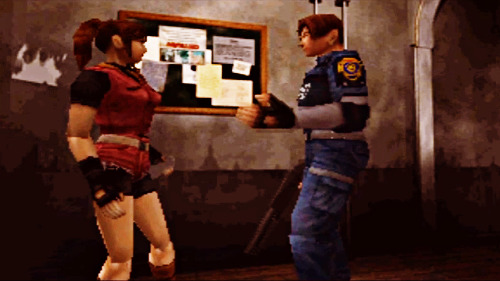
Claire and Leon working together, solving the problems...
RE2O’s scenario system was a fairly interesting way of presenting the story of two characters, and I always wondered why this was never more of a thing in games. Claire and Leon’s plot were separated on two discs (PS1). Leon was first, Claire, second. Completing one character’s “A Scenario” unlocked the other character’s “B Scenario”. Certain gameplay actions created minor consequences to affect the respective character’s scenarios (if you took a certain weapon or item over another, it wouldn’t appear in the other character’s alternate scenario).
The scenario system and the corresponding plots of the player characters were clearly developed in tandem with each other. Whatever goofs arose from therein, the narrative position of the characters remained firmly in place (largely because they were told through cinematics).
Claire’s B scenario always felt the most changed because the cinematics had to accommodate for a change to get Claire in places I was otherwise unaccustomed to seeing her. Legit, some of the cinematic differences were wild.
Back in June 2018, Capcom made it clear that RE2R was not intended to have a scenario campaign at all. The decision was (apparently) made back in 2017, when it was clear doing an A/B scenario was going to be costly on a AAA budget. It was only going to be a single campaign for Leon and Claire. So, Claire and Leon’s campaigns in RE2R are, structurally and plot-wise, “Scenario A and B did a fusion dance”.
In execution, their campaigns are like choose your own adventures. It asks the question “what if you went with Claire?” and its answer is “Leon de-spawns and doesn’t appear again until the end of the game”. It’s definitely not “Two strangers walkie-talkie a plan to escape a zombie infested city”.
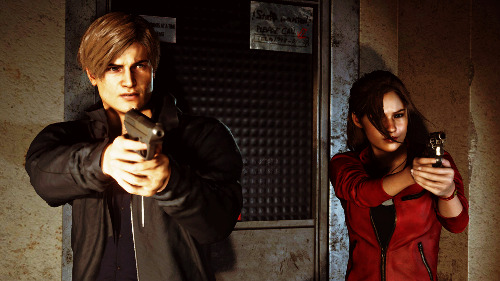
Inside or outside, the B Scenario for the player characters barely differentiates itself from Scenario A
In this case, they should’ve stuck to their guns, just released one campaign per character (it’s not exactly like the absence of the B scenarios would actually impact their sales. Not with the fans whipped into a frenzy) and focused on getting their plot to work a little better.
“Claire B” and “Leon B” come off like a slapdash cut-and-paste job that made me question whether or not I had hit something on the controller that was causing the sequences to skip right through whole gameplay segments. Yet, now armed with the knowledge of a year before, it would explain why nothing in this game’s presentation ever feels like it gels, or was hastily put together.
Another issue the RE2R’s alternate scenarios make is not maintaining the characters static narrative placement as RE2O did. I think this is where you really start to see how little interest Capcom had in Claire as a character versus Leon.
RE2R’s “Claire A” Scenario opens with a brief clip of Claire on her bike, talking to someone on the phone about Chris, then hearing something in the gas station store. The game then proceeds to put her in the exact same circumstances as Leon, which is baffling. They really have her doing the Leon shtick and repeats what she did in “Leon A”, but inside the gas station. Whack.
If you play “Leon A” first, she appears out of nowhere like she’s been attacked outside the gas station somewhere nearby. Her motorcycle isn’t even anywhere in view, so, the natural assumption you make is that maybe they’ll show that later when you play “Claire B”. Maybe there’s another area you can explore.
Nah. In “Claire B” the exact same cinematic plays again, trailer music starts, cut to black, and, it jumps to her intro scene in “Leon A”. At no point are you given a unique gameplay level or cinematic for Claire to bridge the gap between Leon heading for the store exit and Claire being chased by zombies that suddenly surrounded the gas station. She lit. just spawned into the area! Whack.
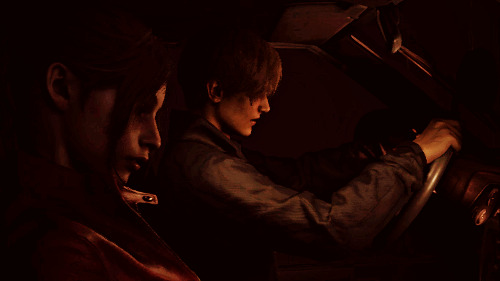
Now for some awkward car dialog
The original game was smart enough to give you a cinematic where she scoped out an empty diner and happened across some zombies while Leon’s boots were being accosted outside by zombies near his jeep. It really sold the idea of events happening concurrently to two different people within the same area.
Claire in “Claire B” doesn’t even get a section where she runs through the city after escaping the T-bone incident. The game just drops you in the graveyard, and then drops you at the rear police station gate where Leon spots her outside. You do a lot of backtracking in RPD with zero character interaction, and then, about an hour into the game, you end up on the exact same track as you did in “Claire A” (meeting Sherry, saving Sherry, Birkin #3-5 fight, escape) with no scene restructuring or whatnot, just the standard “Extended Ending” shtick.
“Leon B” in RE2R shares the exact same problems as “Claire B”. It feels like an abridged version of “Leon A”. Beyond Leon standing outside the gas station store and instant transmission’ing to the back of the police station there are zero story differences. But, with Leon you always have the reassurance that you can just play “Leon A” if you want a more complete experience.

Driving motorcycles in the rain is, factually, an accident waiting to happen
Claire regardless of the scenario you choose for her, A or B, will never get a unique starting gameplay moment of her own. While I think they did a far better job of reworking “Claire A” better than either of Leon’s scenarios, that’s disappointing. Claire really feels like something of a afterthought.
Other detractors from the scenario nightmare include Mr. X following you around in the A Scenario and the B Scenario, instead of the B scenario only. Mr. X went from a fairly unsettling stalker of a boss enemy, who worked on slasher movie principals (the monster appears out of nowhere when you least expect him), then quickly transformed in a wearying exercise of dodging an enemy type that overstays its welcome. Both scenarios feature the helicopter crash and skylight Licker ambush, etc., etc..
If they couldn’t build upon or better realize what the 1998 game did, then the B Scenario was best left to the wayside. Naturally, Capcom didn’t follow their own advice and the want to cater to nostalgia bit them in the ass.
Water is wet.
II. Gameplay – Night of the Living Bullet Sponges

Lickers (who are still terrifying) are practically one-hit-kill monsters now. Yippie.
There is a lot about the cinematic presentation of the elder Resident Evil games that defines much of its identity. An identity strong enough that most games that came out during the high point of its career were content to copy or refine its formula (Temco’s Fatal Frame, Konami’s Silent Hill 3, and Capcom’s Onimusha and Haunting Ground for example). There is a lot that loses the more it – a two decade old franchise – attempts to keep up with an ever-changing landscape of what’s considered modern-gaming-at-the-moment, instead of going to sleep like Onimusha, or even being forcefully put out to pasture like Silent Hill and Dead Space.
RE2R is a standard third person shooter that de-emphasizes cinematic presentation within its plot and its game space. There are no establishing cinematics, and the Kamiya action-movie-esque flair that made the last stretch of the climax what it is, is thoroughly absent. RE2R instead opts to – present the plot of the game completely within the game space itself with minimal cinematics. Sometimes it works, other times, it doesn’t.
Lickers drop unceremoniously on your head in your first encounter, Mr. X just appears out of nowhere then hounds you like Jehovah’s Witnesses, the sound of a helicopter crash goes whizzing by in time for you to walk past the model that’s already in the wall, Marvin becomes a zombie with no real sense of mourning or terror about his passing, Ada Wong gets the worst on-screen send off, etc. Cinematic moments that were meant to emphasize and foreshadow the decaying situation of the police station and the stakes of the characters are just kinda nullified.
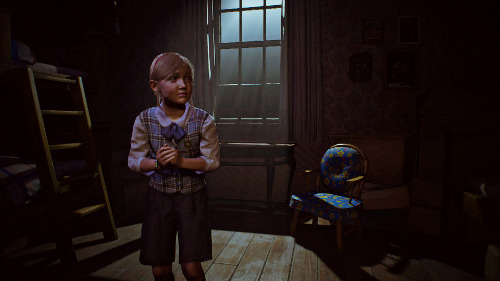
Sherry Birkin’s gameplay segment is one of my favorite parts of the reboot.
I think one of the reasons Claire’s campaign leaves a better impression on me than that of Leon’s is what they decided to with Sherry Birkin’s part in her plot. Leon’s scenario has Ada trudging through a boring sewer corridor hunting for fuse boxes and then the game knocks her out so Leon can come to her rescue. With Sherry, you get something a little more creative, something that doesn’t treat her like a momentary distraction from the player character like it does with Ada. The entire orphanage level, from its presentation, to its level design, is probably what I would’ve liked to haven seen more of in the game.
The game puts you in the shoes of Sherry, but instead of traveling through sewers on your own, you’re exploring and searching an empty building that invokes a mood similar to – but not like – 2002’s Resident Evil. Obviously, this choice was made to keep Leon and Claire’s paths from intersecting (fuck that, I guess), and in a lot of ways, the game abandons the mechanics of Resident Evil and becomes a modern Clocktower game.
Chief Irons becomes the scissorman to Sherry’s Jennifer Simpson, and you, the player, have to navigate a fairly limited space to get away from him. They basically expand upon the Natalia stealth segments from Resident Evil Revelations 2 and create a fantastic gameplay segment full of distressing near misses and a legitimate win for Sherry. (I only wish they had allowed her to lock Irons in the bathroom. He would’ve Nicholson’ed his way out anyway.) Unfortunately, it ends with a Deus Ex Birkin appearance and leaves the player asking more questions that it’s not interested in answering on any level. Also Mr. X just spontaneously appears as well, which only compounds the Deus Ex Birkin thing.

Where you could soccer kick a head from a zombie in the original, Claire and Leon can barely expend energy to shake ‘em off their shins. Fantastic.
Combat wise, in a lot of ways, RE2R feels like a chore. A regression of the advancements that RE4 and RE1R was able to strike a balance with, but later iterations leaned too heavily on or used too little. Hell, I even think it’s a regression of how Dead Space approached combat. RE1R encouraged the player of doing away with zombies much in the same fashion as its counterpart and RE2O, with tactile and visible indicators that the zombies were dead (pools of blood under the body, dismemberment, headshots), but, it also threw in the risk of dealing with a new threat (Crimson Heads) if you chose not to oil and burn the bodies you left behind as you cleared the area. The gameplay was solid about letting the player know their resources had been put to good use.
RE4 encouraged smarter gunplay, aided by laser sight, and critical damage hits to other areas of the Ganados. The risk of taking headshots were being attacked by the parasites that could take large chunks of your health out in tandem with the mobs that – one way or another – would catch up to you. Dead Space took the critical hit system of RE4 and transformed it into a mechanic that made the complete dismemberment of the Necromorph critical to survival. Effectively, both you and the enemies were fairly balanced against each the other. You were never so strong that you could blast through your opponents and your opponents were never so OP that you lost unnecessary resources trying to kill them.
The same really cannot be said of RE2R. Nothing about the combat or enemy encounters feels particularly balanced for much of anything save busywork and resource death. There is no real balance between yours and the strength your opponent. I’ve heard RE4’s adaptive difficulty is still in play here, but if it is, its implementation here is not great. I certainly never reached that flow-state where I felt I was in harmony with the game.
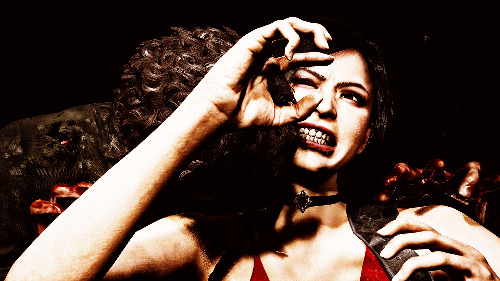
Yeah, I didn’t miss this bit at all.
Headshots are nullified in a way they’ve never been in the series, and right off you can tell what the devs consider a “challenge” in terms of gameplay. Zombies eat bullets as badly as any mid-tier B.O.W., regardless of what difficulty setting you choose. In standard I saw six-to-nine bullets go into the head of a zombie and there was no guarantee they were dead until you saw their head explode or maybe saw them twitch. In hardcore (my sister’s preferred mode), zombies will eat eight-to-twelve-or-more bullets to the head and the consequence is the same.
It’s imperative to try and incapacitate the undead, because minimizing your enemy count in RE2R is an exercise of frustration and often, a waste of bullets. Zombies move far faster than they did the original iteration of this game, practically zapping over to you no matter how much space is between you and them. They do just about the same, if not more, damage to you. The common defense against this is grenades, flashbangs and knives. If you haven’t used them for other things (like Ninja vanishing or crowd control), it’s the quickest way to get out of their hold. It’s simply not as reliable or was enjoyable a method to fight the zombies off in the vein RE4 provided (German Suplexes, kicks, elbows to the face, a knife that isn’t dollar store plastic, dodging, etc.).
If you can avoid them, by all means, avoid them. The consequence, however, is if you have to backtrack, well, you might be running into a bigger crowd, one that may include the problem monster of the given area (Lickers, Mr. X, Dogs, Plant Monsters, etc.) and potentially less resources. It’s a particular problem in the police station with Mr. X following you everywhere and not being remotely helpful enough to do some of the killing for you. He just gently pushes them out of the way.
A lot of the time, my sister was preoccupied with head-shots (against all odds) while I spent my time (trying to) cap their knees, and remove their limbs (so they couldn’t grab us after I capped their knees) so we could sprint our way through environments when the opportunity presented itself (largely to save ammo for another problem area). She’s the better shot, I’m only great with projectile weapons (so Claire’s campaign is even better to me in that regard), which I largely prefer on principal of strength. For me, there is no real satisfaction in the game’s combat, not even in a fight-or-flight sense (prime example: the village and castle encounters in RE4), or on a level capable of inducing the worst panic attack in me like Dead Space 2′s opening hospital sequence.
I was frustrated with near misses. My sister was a little more forgiving about the changes despite never being to make the clean headshots she wanted. We only really agreed on mutual dislike of the boss battles, but’s more or less how we feel about all of RE’s bosses. There is not a single one we’ve enjoyed fighting, and the worst ones were all in RE6 (which literally had us not talking to each other for days afterward) and Revelations 2.

Local zombie mocks police station’s lack of shutters
RE2R is pretty generous with its ammo cashes, with most of what you need readily available. The map, for the most part, makes locating items easier, but spotting them poorly lit environments, and around mini horde-like numbers that seemingly materialize out of nowhere is a bit of chore. Rarer types of ammo, like shotgun or automatic weapon ammo are often hidden in safes or lockers with combination locks.
Resource management returns in the reboot, copy-pasted from RE7, right down to the stark menu and a minimalist design that makes item management, I guess, less busy (color wise). It works, so it doesn’t bother me in context. The maps are definitely easier to read and a little more explicit about what items are where, but have otherwise maintained the “cleared” / “in progress” blue and red dynamic.
Depending on the difficulty level you’re playing on --- easy (assisted), normal (standard), or hard (hardcore) ---, your resources will be readily available to you, somewhere in the middle, or few and far between (in practice). Hard mode will have you rely on ink ribbons to save your game (like a standard PS1-PS2 game), and I think there are no checkpoints. Save points are scattered in new locations and are a brief safe haven.
Puzzles in Resident Evil have always been a series of frustrating events, particularly slide-and-complete-the-picture and “find the missing themed piece” puzzles. But, this game actually made me appreciate them, largely because the gun-play is no longer a satisfying aspect (and probably will never be again).
Mechanically speaking, a lot of the puzzles or item hunts from RE2O are sort’ve retained, but they’ve been mixed up or their importance to getting to one place or another has been (extremely) reduced or made even more convoluted. The reboot is definitely not that interested in puzzles, so it feels and is designed less like a dungeon crawler.
Item hunting in order to solve puzzles requires you backtrack quite a number of times through the environment-of-the-moment. However, backtracking is perhaps more nightmare-ish and gauntlet-like than previous entries because it seems like the game spawns more zombies into the area. And with Mr. X basically breaking the exploratory pace of the game, the want to explore your environment is actively discouraged.
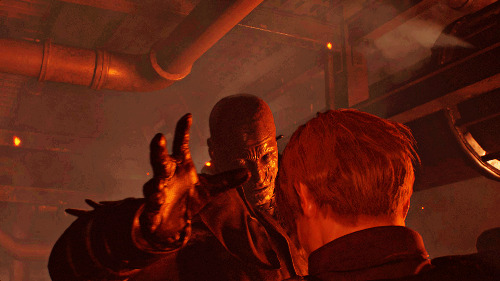
[Sighs Loudly For a Thousand Years]
Despite the game’s over-reliance on Mr. X, breaking from the series formula of not over-exposing its mini-bosses (the Regeneradors, Verdugo, or even that huge Centipede in a Trenchcoat for example, were not following you everywhere), Mr. X was, for a short time, the only ‘combat’ element in this game that invoked the right kind of déjà vu.
It was actually satisfying knocking him down, and ducking his punches at the last minute. I mean, at least it was in levels having nothing to do that Ada Wong segment. (Then. he. kept. coming. back.)
Ending him isn’t quite as satisfying as it is in the original game. Not because he effectively became an SNK boss, but because the component that makes that fun (The Resurrection of Ada Wong and the emancipation of the Rocket Launcher) was removed entirely from the game for a sequence far, far blander in comparison.
III. Non-Union for Billion Dollar Corporations

Around 2015 or so, there were rumblings (outright vocalizations) from unionized voice actors that shed some light on some particularly horrible business practices that developers and publishers were carrying out on voice actors. They were either not being paid their due, or not allowed proper rest-time during the jobs they worked on. Big studios like Insomniac Games, EA Games, Activison, and the like were mistreating voice actors, often to the point where some confessed to experiencing vocal damage, stress or injuries sustained from shitty work conditions and people who clearly viewed their occupation as a lesser division of their project’s production.
At the same time, well before the strike became officiated, Capcom made the conscious decision not to hire unionized voice actors for the production of the Resident Evil 2 reboot. No one knew about this until 2017, when the game was well on its way to being released the following year (before a delay pushed it to 2019) and the Strike was ongoing. Alyson Court (on-again-off-again VA of Claire Redfield), Matthew Mercer (the most recent VA for Leon), and Courtenay Taylor (the most recent VA for Ada Wong) all announced that they weren’t reprising their roles in the game because the reboot was not a union project, but it was not a result of the strike.
Some vocalized their displeasure with this, even going as far as to say that they wouldn’t buy the game in a show of support of the actors. Others aren’t sparing it a glance because they’re otherwise disappointed with the creative direction anyway. But if the reception of the game from basic users – aware of the circumstances or not – is anything to go by, solidarity will typically lose out to FOMA (Fear of Missing Out). Especially if you’re not getting anything out of it personally or emotionally as a consumer of media.
I’m not particularly interested in demeaning non-union voice actors, (I’ve watched and paid for many a-thing that used non-union labor). Capcom, despite working on union projects, also continues to dabble in non-union label as well. I know Capcom’s likely wasn’t interested nor aiming to help voice actors not represented by SAG-AFTRA (or other organizations) become better known or gain better opportunities.
The less money they can probably shell out with non-union work, the better it is for them in the long run. Knowing the striking voice actors didn’t remotely get what they wanted out of negations (and probably didn’t get the support they wanted on account of whataboutism) will probably only embolden Capcom and other publishers and developers to make/continue behavior like this, whether or not another strike ever occur.
Resident Evil has never been particularly known for its voice acting beyond the scope of how terribly it started out in 1996 and kinda petered out on the platform of “meh, it’s not completely terrible” with later entries.
The series could hire some fantastic voice actors (Rino Ramano, Karen Dyer, Sally Cahill, and Paul Mercier, for example), and a lot of them can deliver some dud performances regardless of experience. At the end of the day, unless they have an equally strong director and screenwriter, you’re going to end up with an embarrassment of riches that may become memes one day (“Complete. Global. Saturation.”).
That said, RE2R’s issue seems to lie primarily within the writing. In an attempt “humanize” characters, major to minor, the script is often littered with profanity that not only distracts from the point of what you’re reading or listening to, but adds unnecessary fat to a script that’s already bogged down with dialog and text.
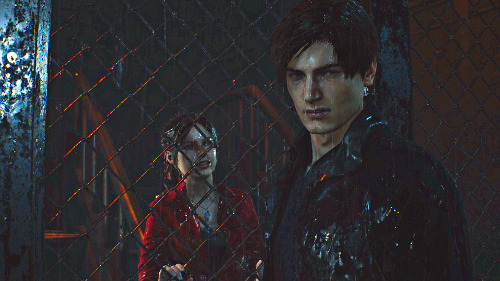
The downside to a rebooting a 20 year old game, is when corporations indulge in fandom bullshit. RE2R is pretty rife with cutesy dialog meant to whip the “Cleon” shippers into a frenzy. Its nauseating, really.
Claire and Leon’s conversation at the back of the police station is a prime example of that: Instead of having the dialog delivering urgency of the scene, the objective of the characters we get an aimless exchange full of flirty dialog, and two characters not all that concerned with zombies materializing behind them (given they take forever to put the fire under their boots). In RE2O, at least the writers were smart enough to have the characters meet in a zombie-free room or hall.
I’ve seen people make the Realism™ argument constantly with this game (esp. when counterpointing the gameplay criticisms), but, "realism” is a weak argument and esp. when you’re simply looking to be dismissive. When dialog begins to wander from its point, when profanity hinders more than helps your delivery, your story not only loses impact, it rather shows you’re a mite lazy or weak as a writer.
Comparatively, RE2O was able to communicate the urgency, anger and tone of their characters, and under no circumstances were they this reliant on profanity or long-winded dialog. The issue isn’t that profanity is present, or that the game is text or dialog heavy, it’s how its executed. And at present, the execution is lacking in a strong focus or reduces the game to script written by someone who just realized, “wait, I can make characters swear????”
I can honestly see why a lot of protagonists in survival-horror games were silent for so long outside of cinematics, or simply had substituted thoughts (”I better find Ashley quick”). Running commentary really does break the immersion.
Claire and Leon go from mildly relatable to mechanical models spewing canned reactions that lost their bite forty minutes ago. It’s like being stuck with multiple versions of the Generic Husband from RE7 who “what the fucks?” at every single thing when given the opportunity. So, in a lot of ways, it has a lot of the same problems that made the dialog in Resident Evil Revelations 2 anguish to listen to (hello, Moria Burton), but it lacks such charming (/s) quips like, “Holy balls, my life is awesome!”

That said, not all of the performances are terrible. The voice actors for Claire (Stephanie Panisello), Marvin (Christopher Mychael Watson) and Sherry (Eliza Pryor) probably leave the greatest impression, and are arguably the strongest performers in the game. Christopher Mychael Watson in particular gives a wildly different performance depending on who you’re playing as (Leon or Claire) and has the strongest rapport with Stephanie Panisello.
Nick Apostolides, on the other hand, he just turns in a really unremarkable performance as Leon. Like, in comparison to Mercer, Mercier, he simply does not charisma to inject personality into what is an otherwise really boring version of Leon. He definitely doesn’t have the hammy, but dead-serious delivery of Paul ”why does no one listen to me?” Haddad (Leon’s original VA).
I think one of the more disappointing sequences in the game is when Leon returns to the main lobby in the station and gets jumped by zombie Marvin. Instead of sounding devastated, Leon just sounds mildly disappointed his C.O is a zombie (Panisello gives you a better impression of Claire’s heartbreak). And because this scene isn’t a cinematic, you as a player are just running around in circles hoping you have enough ammo to kill the bullet sponge zombie Marvin. When Marvin is finally a gory mess on the ground, Leon saying, “Don’t worry, Lieutenant. I’ll stop this” (paraphrasing) to the pieces of Marvin’s body, comes off as unintentionally hilarious, right down to the delivery of Apostolides.
My feelings are about the same on Jolene Andersen (but we all can’t be Sally Cahill, can we?), but also makes me wonder why Capcom didn’t go the distance to hire a Chinese-American voice actress for Ada. They clearly had the opportunity to do so, they found a Black actor for Marvin, but they just didn’t bother with Ada.
The worst performances out of the bunch is probably Daddy Gunshop owner, “Hello Human” reporter guy, Annette “You’ll Never Get the G-Virus” Birkin, and Chief Irons.
IV. Capcom’s Adventures in Sexism Rebooted

One of these characters had some thought put into their design. It’s not the character on the left.
The Resident Evil series is no stranger the sexualization or objectification of female characters. Historically, for every step forward Resident Evil takes with the presentation of its female characters, it takes six steps back. If there is a female character in the series, the chances are she’s going to be wearing something meant purely for the male gaze, while her male companions wear something far more appropriate for the game’s plot. It only gets worse with alternate costumes, which are typically comprised of sexy school girl fantasies, Daisy Duke hot pants, anti-Black fetishism, and little red riding hood looks. (And no, costumes like Chris’ Sailor Man and Mad Max looks aren’t a counterpoint gotcha.)
RE2R, on the surface, seems to be yet another step-up in the presentation department for female characters in the series. Claire is wearing a leather jacket over a black tank top and sports jeans instead of shorts in new her default costume, they even presented Ada Wong in a world’s ugliest looking trenchcoat. Even better, one of Claire’s alternate costumes is a suit pants and shirt look. Claire has three alternate costumes that aren’t even remotely fanservice-y in the least and it’s great.

Then Capcom announced the “Classic Costume” for Claire and finally revealed Ada Wong without the trenchcoat, and it was business as usual. Claire Redfield’s “Classic Costume” in the reboot is, for lack of a better word, closer to fanservice-y than the original leotard under shorts, black shirt, and vest combo ever turned out to be. The only marked improvement made are the shorts are equal to the length of the leotards and no longer look like underwear.
Where the tank top worked with her new jacket and jeans, it throws the entire look of the original costume’s framing off, and based on the cinematics. While it’s nowhere near as sexualized as her Revelations 2 alt costume, Capcom’s intent here is pretty clear.
Effectively, Claire looks closer to a character who would appear in a Michael Bay produced horror film, whose talking points are usually how sexy the actress makes being terrified look. In the original she was simply meant to look “cool”. When she removed the vest, and wore the holster over her black shirt, she did.
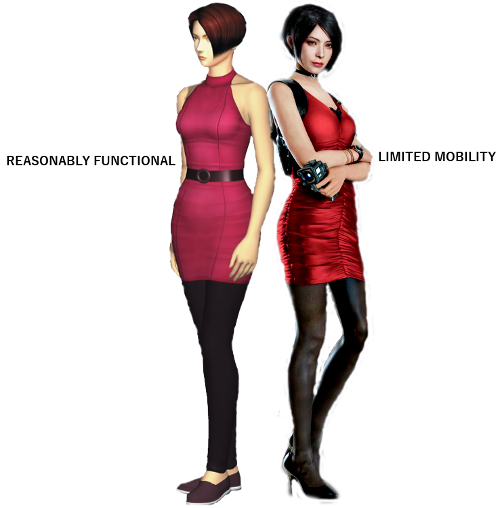
Ada Wong goes from wearing a halter top dress with leggings, and flat heeled shoes that looked fairly maneuverable in, to looking as though she’s been zip-locked into a red slip that doesn’t fit her, finished off with a tacky tiny black bow, a choker and two inch heels.
The entire look of it rather screams at you like a flashing ad banner advertising for an explicit website fetishizing Chinese-American woman. A lot of the fan art coming out of the fandom for Ada Wong in the remake is reflecting more or less that, so the target audience has been completely satisfied in this regard.
She looks absolutely ridiculous in gameplay segments because the dress was designed with no reactionary physics. It doesn’t flex the way a dress does around legs. It looks like a bad mod made by a fan that wanted a “sexier” looking Ada Wong.

Even outside the context of alternate costumes, female characters like 18-Year old Rebecca Chambers (who isn’t even in this game) ends up being oddly sexualized in a photograph where she was originally just sitting on the ground with a basketball in front of her leg, grinning like a goofy kid on a Scholastic paperback from the 90s.
Were it not for the fact that they were legitimately aiming to make Annette Birkin look undesirable, I’d be surprised that she didn’t appear in this game wearing a lab coat, half-open dress shirt, office skirt and three inch heels with heavy makeup.
Meanwhile, Leon Kennedy gets a “Classic Costume” that gets no [major] alternations to its look and thus is restored, unlike Claire or Ada, normal civilian clothing, and a Noir costume. Ada basically got no alternate costumes despite her playability, and I think it was the same with Sherry as well?
Standard, tried and true sexism aside, when it comes right down to it, even if your female character has the reputation of characters like Leon, “How can I make her sexier?” is a question Capcom all too readily answers instead of being creative.
V. RE Engine or, a Trip into the Dark Valley of Uncanny Gray People Land
Photorealism in games isn’t something I’m crazy about and how I react to it ultimately depends on the developer. A lot of video games have been worse for it – dead eye and plastic looking characters is an issue that persists – while very few have used it to the advantage of their creativity.
The major thing that puts me off is the blandness of a photo-realistic white faces. Developers are have shown they can sleepwalk a photo-realistic white face with no issues, but when it comes to the faces of people of color, well, either their biases start to show in the designs (its real easy to make a caricature of Black or non-Black face for video game devs) or their limitations are inherent in their how they see faces that don’t look like them.
I find myself struggling to say what I enjoyed about this game on a visual aspect, because its biggest detriment is without a doubt the RE Engine.
Environment Design - You want it Darker

Creative Assembly’s Alien Isolation did something I really liked. And that’s make the player reliant upon its darkness. You spend as much time in the light as you do enshrouded in the dark. The A.I. systems of Amanda Ripley’s enemies: Hostile humans, androids on an aggressive warpath of helpfulness, and the Xenomorph make hyper-aware of just how exposed you are bathed in the light, just as the dark and shadow make you equally aware that you’re just as open to an attack from the Xenomorph who needs no light to see you should it ever spot you therein.
A lot of the design philosophies in RE2R were built on the groundwork established by RE7, but its disadvantage was the player’s familiarity with RE2O’s level design. In a lot ways, I think they opted for pitch black environments to break that confidence. There are several environments throughout the presentation of RE2R that are turn-the-lights-off dark (which makes for an unpleasant experience for my eyes), but in a way that’s more superficial than essential.
Most areas in the game contain low-level lightning most of the series is known for, but it lacks any of the color and saturation from older games that make set pieces stand out. The most light you’ll see in RE2R is within the lobby, library and upper offices of the police station and the underground lab at the climax of the game.
The closest the game ever gets to replicating the atmosphere and mood of the older Resident Evil games is probably the orphanage level and the later street level in Claire’s campaign. The lightning and shadows are perfect there. But, more often than not, RE2R is content to plunge you into a adversarial darkness repeatedly with a flashlight. In addition to the game’s muted or desaturated colors and washed out look, nothing about the environment design really stands out as remarkable outside of the aforementioned levels.
I don’t think I’ve read so many complaints about having to adjust the contrast, color, brightness, and etc just to get one area or another to look normal before this game (in relation to RE). It’s apparently bad enough that PC Modders are creating mods that fix the overall presentation of the game (more color contrast, sharper image, improved lightning). Devil May Cry 5‘s environment and lightning design tends to looks leagues better than this game, and its got its fair share of bland looking levels.

The screenshot is edited, but this is a solid approximation of how dark it is in a lot of areas.
Where almost no light worked in a game like Amnesia: The Dark Descent, SOMA, Penumbra, or even Silent Hill, RE2R’s design template actively discourages exploration in a way the older games did the opposite. It gives you the impression that the game has more to hide than it does to show you. The 2002 Resident Evil remake is still one of the best examples of cinematic light, dark, and shadow created purely for navigation purposes. The game is seventeen years old (holy shit), and legit, I don’t think there is a Resident Evil game in the series that nails how essential lightning is to your environment like this one.
On an aesthetic level, the reboot fails to capture the period of the world that its predecessor was basically developed, lived and breathed in. Setting aside product placement (“Pepsi”) and musical cues (“Baby one More Time”) is beyond Capcom’s budget, it’s the little things about the environment and level design in the reboot that really fails to say, “Here lay 1998. We’re a year away from the full-blown Y2K craze, floppy discs, and pagers were still a thing.”
There’s a tape recorder, yes, there are big, blocky computers sitting on hardwood desks and gas prices I still can’t believe my father grouched over in comparison to the shit they have us paying now, but, a lot of those things feel like superficial window dressing on a poster board.
The environment design and world of RE2R feels very much like a 2019 era world with very little ringing true of the 90s.. I don’t think any damages the authenticity of the world much like the design of the characters – who look a little too 21st century as opposed to individuals trapped in a moment of time – now twenty years ago – and the same can be said of the secret evil lair of the Umbrella Corporation.
Everything in the final level of the game feels like something of Paul W.S. Anderson’s Resident Evil (The HIVE), and less like a lab that was built and constructed with what a 90s era architect would think was cutting edge tech and aesthetic of the late 1990s. It got to a point where I honestly think they should’ve just set the reboot in 2018.
Character Design - Petrified Faces and Awkward Mouths

He’s lit. melting in the rain right now.
Photo-realistic characters live and die by how well they imitate life without setting off the alarms in your mind. RE2R falls on the spectrum of “missing your mark” in a lot of ways. Characters in RE7 had the look of wax mannequin dolls walking around terrorizing you’re equally doll-esque player characters (with no heads). Nothing about how these characters were rendered and animated was particularly great, and it constantly triggered the meant response of “there is something wrong with what I’m looking at” that often comes with the uncanny valley.
The biggest issue facing the grand majority of the white characters RE2R is the fact that Capcom is still manipulating faces like they’re still using stylized animation and not an engine “based in reality” to its detriment. Characters are puppet-esque, or look particularly unfinished in the washed out environment and desaturated colors. This is noticeable in throwaway characters like the trucker in the opening cinematic (eating a burger that reacts unlike food) with a face that seems ready to melt off of its model at any moment, Chief Irons, “Hello Human” reporter guy, and the father and zombie daughter from the trite Gunshop sequence begging for its SAG award. None of these characters emote or animate well and draw the eye to the imperfections of the engine than wow you with its animation.
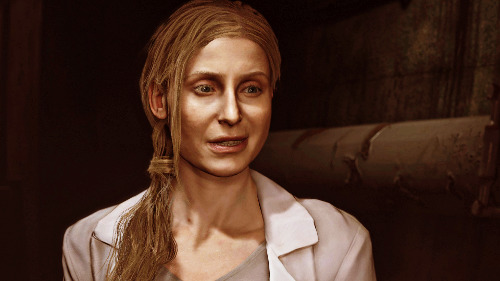
Among the central cast, the characters that look the worst rendered in the RE Engine are probably Claire Redfield and Annette Birkin. Both characters look as though the face models simply did not cooperate with Capcom tweaking the faces. Annette is more puppet-like than say, Claire (who at least has genuine moments of humanity). The less than stellar facial and lip animation is extremely noticeable on Annette's model who might’ve been promoted to minor antagonist at the last minute, because she has no business moving so robotically. It probably doesn’t help matters that Capcom designed her character with the philosophy of “working women don’t care about their appearances” (paraphrased) in mind, which makes their changes to Ada and Claire all the more suspect.
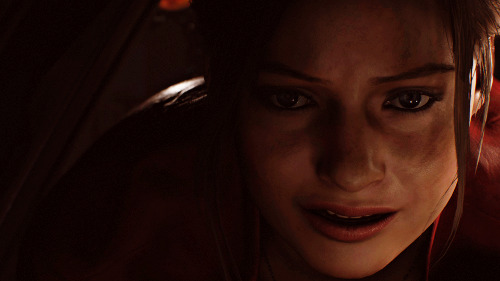
Claire’s biggest issue seems to be that Capcom simply spent less time on her than they did Leon. The model’s face is often stiff and under-animated, so it looks like Claire’s face is struggling to emote. This is especially notifiable when you compare Claire’s model to her living counterpart (who is far more expressive in a still image than her 3D model). Capcom more than likely tweaked the model’s face more than a little bit, and to the character’s detriment. Honestly, it’s comparable to how she ended up looking in CGI film Degeneration (where her face barley animated). Claire’s model really, really, really needed more work, or Capcom needed to find a face they could work with better than the one they chose.

Leon is the character they clearly spent more time on, at least in terms of details. In general, his animations are probably stiffer than Claire. Most of the cinematics involving close-ups of Leon’s face make it appear as though Leon has mastered the art of talking through one’s teeth without moving their lips, and he’s not particularly emotive unless the emotion is an extreme one.
Out of the characters with any remote screen-time or plot-related dialog, the only ones that look slightly more remarkable are Ada Wong and Marvin Branagh. Marvin in particular might be the best example of what the RE Engine can do with unique faces and competent performance from the animators and the actor.
Ada Wong looks better than she ever did in Resident Evil 6, and while this not my favorite rendition of her character on any level, she is only female character in the game – in terms of character design – that got a decent face model.
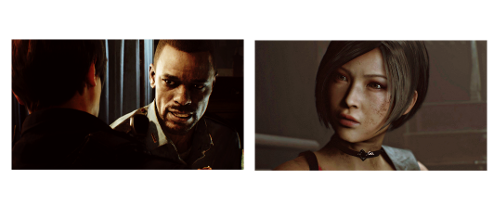
The only drawback with these two characters that Marvin looks as ashy white as the white characters (and no blood-loss isn’t a justification for that) and he shares the same thousand yard dead-eye look in his eyes that a lot of the other characters have. The less-than-stellar facial animation is more than a little noticeable in Ada Wong’s sequences a well (was she snarling or trying to annunciate words at Annette?).
The zombies and non-human enemy types look better suited the grayscale, clay-esque look the RE Engine gives everything. Zombies require almost little to no real facial animation, but against the backdrop of reality they are truly out of place (to reiterate). The same can be said of characters like Mr. X or William Birkin’s monster form.
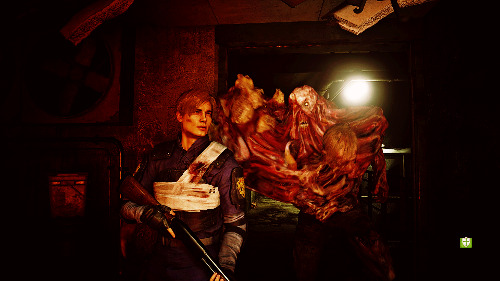
The big sell Capcom made with the zombies and monsters in RE2R is that they could render insane amounts of gore, based on the human anatomy. On paper, it definitely sounds like a cool idea, in execution? I’ve been so desensitized to gore and human guts – within the fictional spectrum – that this really doesn’t impress me. (My sister, on the other hand, needed a moment.)
It’s like, “Yeah, that guy’s arm is are hanging off alright.” But, unless you’re giving me RE4 or Dead Space level styled deaths, where the gore is put on display with a sort’ve Evil Dead irreverence, well, the most your doing is just demonstrating gross anatomy. It’s cool, but not exactly satisfying, esp. when taking the clay-esque look of the models into consideration. The masturbatory gore dislay is also probably a big reason why firearms and explosives against zombies no longer have the desired effect. The most you’ll be doing a lot of the time is peeling the skin off of a model, which I guess, is your cue to go, “Wow, look these physics, look at that gore.”
There are some developers who really know how to work with photo-realistic environments and, even moreso, how to render photo-realistic characters, be they based on living people or not. Remedy Entertainment (using the in-house engine, Northlight Engine), is one, and Naughty Dog – who still rely heavily on stylization – has only recently entered that threshold during the PS4 era.
A lot of this of course, is a consequence of experience with that medium. Naughty Dog’s history with more animated styles definitely helps more than harms their photo-realistic models and environment. Remedy Entertainment’s persistent desire to render the real world in a 3D environment has simply improved as the tech has gotten better.
Capcom, like Square Enix and the late Konami, was always at its best with hybrid blend of animation and photo-realism. Resident Evil was rendered and designed in such a way that it straddled the line of photo-realism and stylistic animation in way no other games did. It wasn’t too real, and it wasn’t too cartoony.
That creative style lent itself to their level design as one was often not without the other. The Gothic horror design of mansions or European countries, and the stark familiarity of places like a police station, a cruise ship or a prison island, were often picture-esque or surreal by design. The RE Engine is probably the biggest step backward in terms of design and atmosphere.
VI. Conclusion – “All Employees Proceed to the Bottom Platform.”
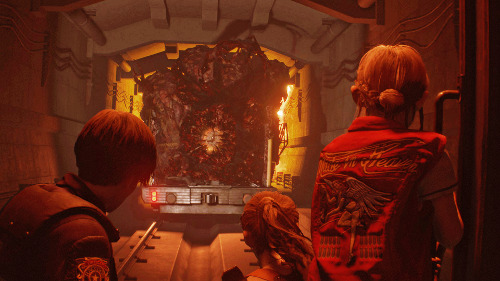
Hey, look, a callback to Resident Evil 2. Neat.
As a game I played with my sister, passing he controller to her every fifteen minutes, I had fun based purely on how she reacted to the game. Whatever my quibbles, the most fun I’ve had with this game is probably screaming and yelling with my sister, and acting as her personal exposition machine.
She asks so many questions about what the hell is going on in the greater scheme of the plot. She doesn’t care, per-say, but she asks anyway because she knows I like reading Wikipedia and thus have the answers. I can only tell her what I know from the previous games, which I know effectively don’t count for shit with this reboot.
That said, the reboot just made me weirdly appreciative of what went into the creation of the original Resident Evil 2, especially in terms of structure, gameplay and presentation. The reboot is ultimately something that feels like it was produced within a AAA space, right down to its paid DLC offerings, which once would’ve been natural unlockables in the game. It’s budget was probably sunk by the over-lavish requirements of the RE Engine, and just from looking at it, this game had budget it was straining against. It ultimately ends up making its predecessor all the more crucial and unique.
It kinda highlights just how useless exploiting nostalgia is in the process of replicating things. You don’t get the same results, and in the end you’re only playing an imitation of something that was a consequence of the right people coming together at the right period of time. It’s what makes things like polygonal character skins, or “play this game with lower resolution settings”, give the impression that devs largely miss the point or misunderstand what people like or continue to like about older productions, even when a newer imitation of it comes out (the discussions people have about Metal Gear Solid vs. The Twin Snakes highlights this best, I think).
I enjoyed Bluepoint’s Shadow of the Colossus, they went above and beyond the call of duty to reproduce the original, but I often find myself playing the older far more than its 2018 remake, because the latter ultimately lacks what Team Ico put into that game.
In its attempts to be a retelling of the game, RE2R probably would’ve been better off abandoning the entire framework and creating something entirely new (I say again). But because it never tries to be different enough from its counterpart, especially in terms of story beats, the end result is a condensed soup with missing flavor. Otherwise, I think restorative would’ve been a better move than remixing it. Not something I could say about Shattered Memories. If I could describe RE2R, outside of the interaction I had with it in the company of my sister, “boring” would be the kindest descriptor I could give it. Everything about its aesthetic, to the delivery as a much toned down version of RE2O, was not gripping [for] me.
Comparing this reboot to something like DMC5, something using the same engine, but manages to be more vibrant in design and presentation, makes RE2R look unremarkable in comparison. The visual quality of the game tended to remind me of the presentation of Ready at Dawn’s The Order 1886, which was also heavily reliant on photo-realistic graphics and a washed out presentation.
This game is nowhere near as engaging as its original. And because the campaigns are basically a Frankenstein hybrid of the original A/B set up, a lot of the changes to the plot seem really superfluous or detrimental to the structure overall.

They really did Ada dirty in this game.
Playing the events of RE2O as more overly dramatic or serious effectively makes for a really dull game. A more reality-based RE isn’t something I’m particularly interested in, especially since the end result appears to be a less exciting product. The fact that they did so little with or reduced characters like Marvin and Ada – who are nowhere near as present or independent of the scenario characters as they should be, just makes for a greater disappointment.
RE2R is a reboot of the original 1998 game in all the ways that are reflective of RE7’s design principals, carrying the pretense of realism on its shoulders. RE2R keeps some of the bones of RE2O, but discards the rest in exchange for something trying really hard to be different, but familiar enough to invoke déjà vu. If you spent the radio silence hoping for the lavish recreation Mikami made of his 1996 original in 2002 for Gamecube audiences, you sadly won’t find it here. If anything this more or less proves something like that will never happen again.
RE2R strives to be a third person iteration of RE7 with an older title. If you weren’t crazy for what a lot of people more or less called “Resident Evil in Name Only” when it was released in 2017, chances are you won’t enjoy your time with RE2R. If you were completely and utterly for RE7, the RE Engine and all that this blueprint entails, you’ll basically have a good time with RE2R and whatever else gets remade under this umbrella.
The last temptation I have toward this game is playing it heavily modified on the PC because the mods for this game actually look like something to mess with. I’m just waiting for the “Classic Ada” costume mod, because that dress is some of the laziest character design I’ve ever seen.
#resident evil 2 remake#resident evil#capcom#re engine#re2 remake spoilers#videogamesincolor#marvin branagh#reboot ada wong#resident evil series#resident evil 2 reimagined
12 notes
·
View notes